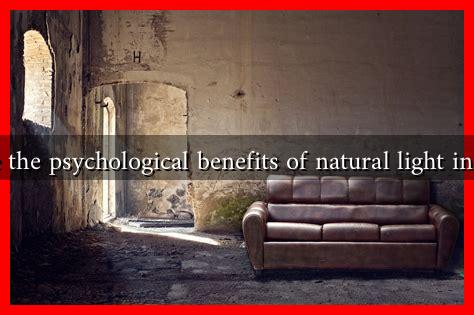-
Table of Contents
What are the Psychological Benefits of Natural Light in Interiors
Natural light is a powerful element in interior design that goes beyond aesthetics. It plays a crucial role in enhancing the psychological well-being of individuals in various environments, from homes to workplaces. This article explores the psychological benefits of natural light in interiors, supported by research, case studies, and practical examples.
The Science Behind Natural Light and Mood
Natural light has a profound impact on our mood and mental health. Research indicates that exposure to natural light can lead to significant improvements in psychological well-being. Here are some key findings:
- Serotonin Production: Natural light increases serotonin levels in the brain, a neurotransmitter that contributes to feelings of happiness and well-being. A study published in the journal Environmental Health Perspectives found that individuals exposed to natural light reported higher levels of happiness.
- Reduced Stress: Exposure to daylight can lower cortisol levels, the hormone associated with stress. A study conducted by the University of Alberta found that employees working in naturally lit environments experienced lower stress levels compared to those in artificially lit spaces.
- Improved Sleep Patterns: Natural light helps regulate circadian rhythms, which are essential for healthy sleep patterns. A well-lit environment during the day can lead to better sleep quality at night, as noted in research from the National Institutes of Health.
Enhancing Productivity and Creativity
Natural light not only boosts mood but also enhances productivity and creativity. In workplaces, the presence of natural light has been linked to improved performance and job satisfaction.
- Increased Focus: A study by the Harvard Business School found that employees with access to natural light reported a 15% increase in productivity. This is attributed to better focus and reduced eye strain.
- Enhanced Creativity: Natural light can stimulate creative thinking. A study published in the Journal of Environmental Psychology found that individuals working in environments with ample natural light were more likely to generate innovative ideas.
Case Studies: Real-World Applications
Several organizations have recognized the benefits of natural light and have made significant changes to their interiors to enhance employee well-being.
- Google: The tech giant is known for its open office spaces filled with natural light. Their headquarters, Googleplex, features large windows and skylights, promoting a vibrant and productive work environment.
- Apple: The Apple Park campus in Cupertino, California, is designed to maximize natural light. The circular building features extensive glass walls, allowing natural light to flood the interior, which has been linked to increased employee satisfaction and creativity.
Practical Tips for Incorporating Natural Light
For those looking to enhance their interiors with natural light, here are some practical tips:
- Maximize Window Space: Use large windows or glass doors to allow more natural light into your space.
- Use Light Colors: Light-colored walls and furnishings can reflect natural light, making spaces feel brighter and more open.
- Incorporate Mirrors: Strategically placed mirrors can reflect natural light and create the illusion of a larger space.
- Consider Skylights: If possible, install skylights to bring in additional natural light, especially in areas that may not have direct access to windows.
Conclusion
The psychological benefits of natural light in interiors are undeniable. From enhancing mood and reducing stress to boosting productivity and creativity, the advantages of incorporating natural light into our living and working spaces are supported by substantial research and real-world examples. By maximizing natural light in our interiors, we can create environments that not only look good but also promote mental well-being and overall quality of life. As we continue to understand the importance of our surroundings, prioritizing natural light in design will be essential for fostering healthier, happier spaces.

